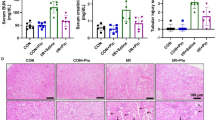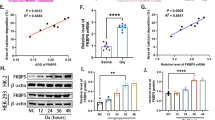Abstract
Cisplatin is widely used for cancer chemotherapy, but nephrotoxicity is a major dose-limiting side effect. Our recent studies in vitro have shown that pituitary adenylate cyclase-activating polypeptide (PACAP) ameliorated cisplatin nephrotoxicity and that the renoprotection with PACAP38 was mediated by the PAC1 receptor and through the p53-dependent and -independent suppression of apoptosis of human renal proximal tubular epithelial cells. In the present studies, PACAP38 prevented the rise in blood urea nitrogen and serum creatinine in mice treated with cisplatin. Cisplatin-exposed mice treated with PACAP38 had relatively well-preserved tubular integrity, even when the treatment started 24 h after cisplatin exposure. PACAP38 also reduced plasma and kidney levels of tumor necrosis factor-α and restored collagen IV levels. The damage to mouse kidney tubules caused by cisplatin involved p53 accumulation and was partially reversed by treatment with PACAP38. PACAP38 ameliorates cisplatin-induced acute kidney injury even when treatment started 24 h after the onset of injury and increases tubular regeneration, which further facilitates restoration of kidney function in addition to its anti-apoptotic effects.





Similar content being viewed by others
References
Abad C, Martinez C, Leceta J, Juarranz MG, Delgado M, Gomariz RP (2002) Pituitary adenylate-cyclase-activating polypeptide expression in the immune system. Neuroimmunomodulation 10:177–186
Antunes LM, Darin JD, Bianchi MD (2000) Protective effects of vitamin C against cisplatin-induced nephrotoxicity and lipid peroxidation in adult rats: a dose-dependent study. Pharmacol Res 41:405–411
Arany I, Safirstein RL (2003) Cisplatin nephrotoxicity. Semin Nephrol 23:460–464
Arimura A, Li M, Batuman V (2006a) Treatment of renal failure associated with multiple myeloma and other diseases by PACAP-38. Ann N Y Acad Sci 1070:1–4
Arimura A, Li M, Batuman V (2006b) Potential protective action of pituitary adenylate cyclase-activating polypeptide (PACAP38) on in vitro and in vivo models of myeloma kidney injury. Blood 107:661–668
Barabas K, Milner R, Lurie D, Adin C (2008) Cisplatin: a review of toxicities and therapeutic applications. Vet Comp Oncol 6:1–18
Bidani A, Churchill PC (1989) Acute renal failure. Dis Mon 35:57–132
Bonegio R, Lieberthal W (2002) Role of apoptosis in the pathogenesis of acute renal failure. Curr Opin Nephrol Hypertens 11:301–308
Chirino YI, Hernandez-Pando R, Pedraza-Chaverri J (2004) Peroxynitrite decomposition catalyst ameliorates renal damage and protein nitration in cisplatin-induced nephrotoxicity in rats. BMC Pharmacol 4:20
Delgado M, Martinez C, Pozo D, Calvo JR, Leceta J, Ganea D, Gomariz RP (1999) Vasoactive intestinal peptide (VIP) and pituitary adenylate cyclase-activation polypeptide (PACAP) protect mice from lethal endotoxemia through the inhibition of TNF-alpha and IL-6. J Immunol 162:1200–1205
Delgado M, Abad C, Martinez C, Juarranz MG, Leceta J, Ganea D, Gomariz RP (2003) PACAP in immunity and inflammation. Ann N Y Acad Sci 992:141–157
Delgado M, Gonzalez-Rey E, Ganea D (2004) VIP/PACAP preferentially attract Th2 effectors through differential regulation of chemokine production by dendritic cells. FASEB J 18:1453–1455
Harmar AJ, Arimura A, Gozes I, Journot L, Laburthe M, Pisegna JR, Rawlings SR, Robberecht P, Said SI, Sreedharan SP, Wank SA, Waschek JA (1998) International Union of Pharmacology. XVIII. Nomenclature of receptors for vasoactive intestinal peptide and pituitary adenylate cyclase-activating polypeptide. Pharmacol Rev 50:265–270
Horvath G, Mark L, Brubel R, Szakaly P, Racz B, Kiss P, Tamas A, Helyes Z, Lubics A, Hashimoto H, Baba A, Shintani N, Furjes G, Nemeth J, Reglodi D (2010) Mice deficient in pituitary adenylate cyclase activating polypeptide display increased sensitivity to renal oxidative stress in vitro. Neurosci Lett 469:70–74
Jiang M, Dong Z (2008) Regulation and pathological role of p53 in cisplatin nephrotoxicity. J Pharmacol Exp Ther 327:300–307
Jiang M, Yi X, Hsu S, Wang CY, Dong Z (2004) Role of p53 in cisplatin-induced tubular cell apoptosis: dependence on p53 transcriptional activity. Am J Physiol Ren Physiol 287:F1140–1147
Jiang M, Wei Q, Wang J, Du Q, Yu J, Zhang L, Dong Z (2006) Regulation of PUMA-alpha by p53 in cisplatin-induced renal cell apoptosis. Oncogene 25:4056–4066
Jiang M, Wang CY, Huang S, Yang T, Dong Z (2009) Cisplatin-induced apoptosis in p53-deficient renal cells via the intrinsic mitochondrial pathway. Am J Physiol Ren Physiol 296:F983–993
Jones TW, Chopra S, Kaufman JS, Flamenbaum W, Trump BF (1985) Cis-diamminedichloroplatinum (II)-induced acute renal failure in the rat. Correlation of structural and functional alterations. Lab Invest 52:363–374
Li M, Maderdrut JL, Lertora JJ, Batuman V (2007) Intravenous infusion of pituitary adenylate cyclase-activating polypeptide (PACAP) in a patient with multiple myeloma and myeloma kidney: a case study. Peptides 28:1891–1895
Li M, Hering-Smith KS, Simon EE, Batuman V (2008a) Myeloma light chains induce epithelial–mesenchymal transition in human renal proximal tubule epithelial cells. Nephrol Dial Transplant 23:860–870
Li M, Maderdrut JL, Lertora JJ, Arimura A, Batuman V (2008b) Renoprotection by pituitary adenylate cyclase-activating polypeptide in multiple myeloma and other kidney diseases. Regul Pept 145:24–32
Li M, Balamuthusamy S, Khan AM, Maderdrut JL, Simon EE, Batuman V (2009) Pituitary adenylate cyclase-activating polypeptide ameliorates cisplatin-induced acute kidney injury. Peptides 4:592–602
Molitoris BA, Dagher PC, Sandoval RM, Campos SB, Ashush H, Fridman E, Brafman A, Faerman A, Atkinson SJ, Thompson JD, Kalinski H, Skaliter R, Erlich S, Feinstein E (2009) siRNA Targeted to p53 attenuates ischemic and cisplatin-induced acute kidney injury. J Am Soc Nephrol 8:1754–64
Montine TJ, Borch RF (1990) Role of endogenous sulfur-containing nucleophiles in an in vitro model of cis-diamminedichloroplatinum(II)-induced nephrotoxicity. Biochem Pharmacol 39:1751–1757
Pabla N, Dong Z (2008) Cisplatin nephrotoxicity: mechanisms and renoprotective strategies. Kidney Int 73:994–1007
Pisegna JR, Wank SA (1996) Cloning and characterization of the signal transduction of four splice variants of the human pituitary adenylate cyclase activating polypeptide receptor. Evidence for dual coupling to adenylate cyclase and phospholipase C. J Biol Chem 271:17267–17274
Pisegna JR, Moody TW, Wank SA (1996) Differential signaling and immediate-early gene activation by four splice variants of the human pituitary adenylate cyclase-activating polypeptide receptor (hPACAP-R). Ann N Y Acad Sci 805:54–64, discussion 64-56
Riera M, Torras J, Cruzado JM, Lloberas N, Liron J, Herrero I, Navarro MA, Grinyo JM (2001) The enhancement of endogenous cAMP with pituitary adenylate cyclase-activating polypeptide protects rat kidney against ischemia through the modulation of inflammatory response. Transplantation 72:1217–1223
Szakaly P, Kiss P, Lubics A, Magyarlaki T, Tamas A, Racz B, Lengvari I, Toth G, Reglodi D (2008) Effects of PACAP on survival and renal morphology in rats subjected to renal ischemia/reperfusion. J Mol Neurosci 36:89–96
Terryn S, Jouret F, Vandenabeele F, Smolders I, Moreels M, Devuyst O, Steels P, Van Kerkhove E (2007) A primary culture of mouse proximal tubular cells, established on collagen-coated membranes. Am J Physiol Ren Physiol 293:F476–485
Vaudry D, Falluel-Morel A, Bourgault S, Basille M, Burel D, Wurtz O, Fournier A, Chow BK, Hashimoto H, Galas L, Vaudry H (2009) Pituitary adenylate cyclase-activating polypeptide and its receptors: 20 years after the discovery. Pharmacol Rev 61:283–357
Wei Q, Dong G, Franklin J, Dong Z (2007a) The pathological role of Bax in cisplatin nephrotoxicity. Kidney Int 72:53–62
Wei Q, Dong G, Yang T, Megyesi J, Price PM, Dong Z (2007b) Activation and involvement of p53 in cisplatin-induced nephrotoxicity. Am J Physiol Ren Physiol 293:F1282–1291
Winston JA, Safirstein R (1985) Reduced renal blood flow in early cisplatin-induced acute renal failure in the rat. Am J Physiol 249:F490–496
Yang S, Yang J, Yang Z, Chen P, Fraser A, Zhang W, Pang H, Gao X, Wilson B, Hong JS, Block ML (2006) Pituitary adenylate cyclase-activating polypeptide (PACAP) 38 and PACAP4-6 are neuroprotective through inhibition of NADPH oxidase: potent regulators of microglia-mediated oxidative stress. J Pharmacol Exp Ther 319:595–603
Yao X, Panichpisal K, Kurtzman N, Nugent K (2007) Cisplatin nephrotoxicity: a review. Am J Med Sci 334:115–124
Acknowledgments
The authors thank Drs. Samir El-Dahr and Zubaida Saifudeen in the Pediatric Nephrology Section at the Tulane University School of Medicine for providing kidneys from p53−/− mice. We also thank Wei Cai and Kristine E. Gullo for assistance with immunoblots, RNA analyses, and bioassays.
This work was supported in part by the Research Commercialization and Educational Enhancement Program of the Louisiana Board of Regents (013RCEEP-07 to M.L., J.L.M. and V.B.), the Dialysis Clinic, Inc. (research endowment to V.B.), and the Arimura Foundation (research grant to M.L.).
Author information
Authors and Affiliations
Corresponding author
Rights and permissions
About this article
Cite this article
Li, M., Balamuthusamy, S., Khan, A.M. et al. Pituitary Adenylate Cyclase-Activating Polypeptide Prevents Cisplatin-Induced Renal Failure. J Mol Neurosci 43, 58–66 (2011). https://doi.org/10.1007/s12031-010-9394-1
Received:
Accepted:
Published:
Issue Date:
DOI: https://doi.org/10.1007/s12031-010-9394-1




